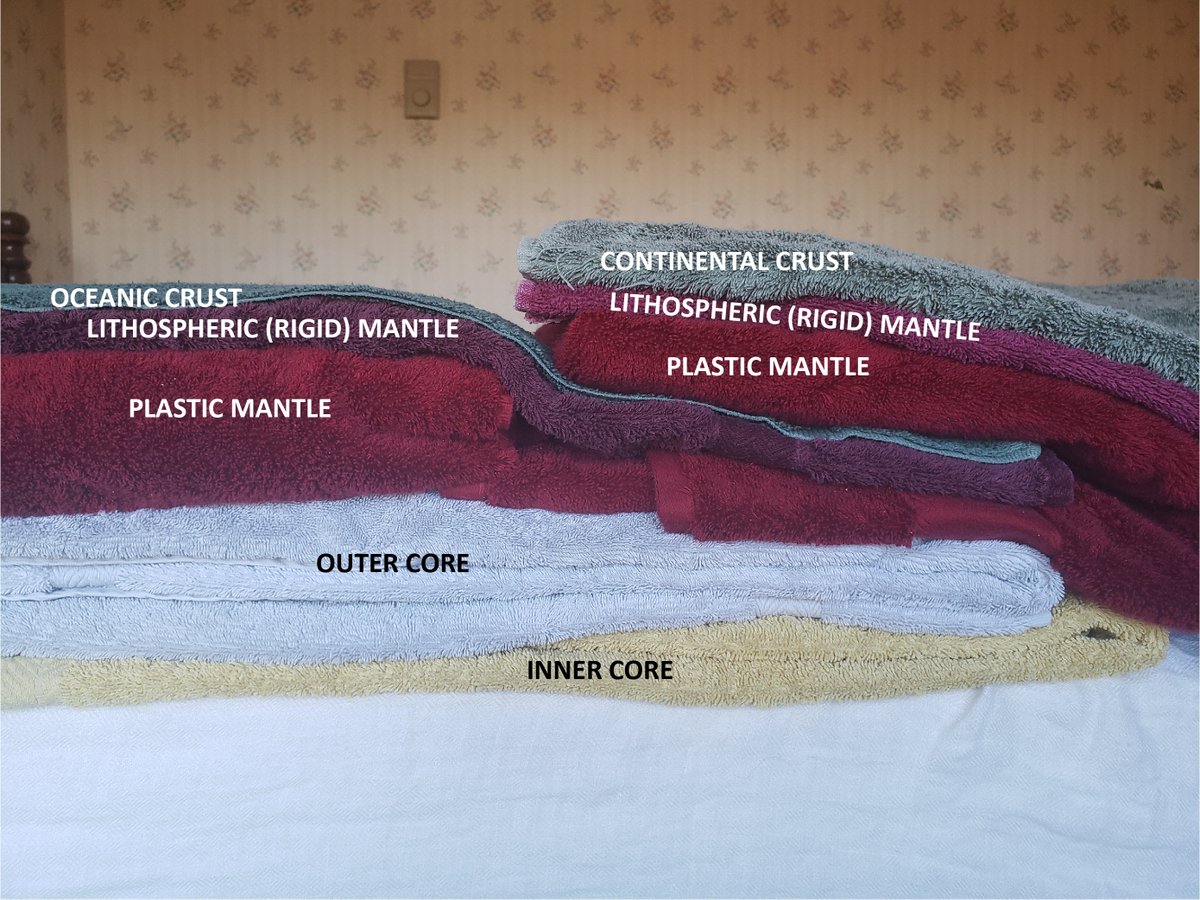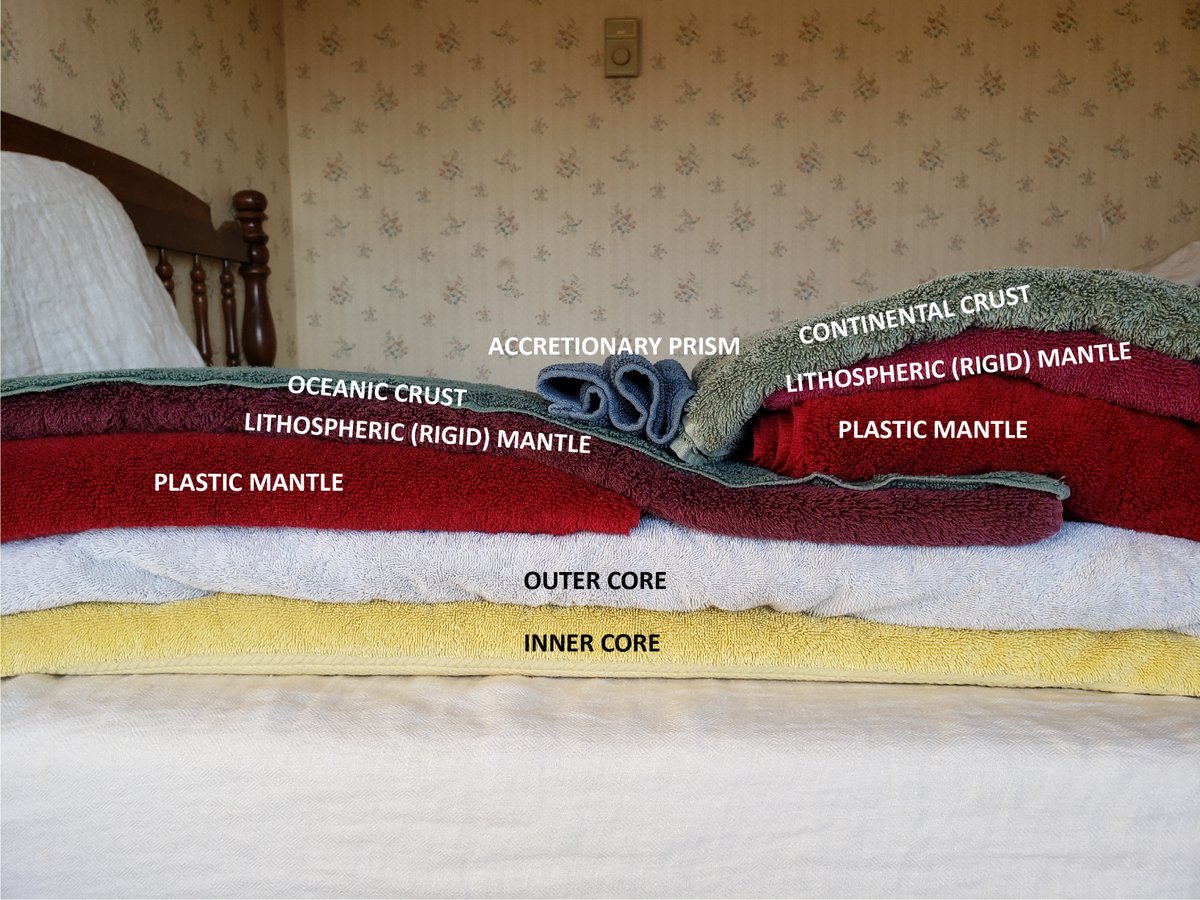Fun idea by @GeologyTime, but this tweet triggered a few of my Earth structure pet peeves. So I made my own version. The following thread explains...
https://twitter.com/GeologyTime/status/1200427421226414085">https://twitter.com/GeologyTi...
https://twitter.com/GeologyTime/status/1200427421226414085">https://twitter.com/GeologyTi...
The key issue that is different between the two versions is the common misconception that tectonic plates are made of crust. The original figure shows oceanic crust (blue) subducting into mantle (grey).
This is a VERY common misconception. But oceanic crust is too light to subduct. It is far less dense than mantle, so it can& #39;t possibly sink into the mantle on its own.
However, the shallowest part of the mantle is cold and rigid. Because it is cold, it is denser than the underlying mantle. Further, it is connected to the crust. This combination of layers is called a tectonic plate. It& #39;s also called "lithosphere"--those means the same thing.
Lithospheric mantle is the darker red in my figure, distinguishing it from the plastic (lighter red) mantle below. Both are mantle--they& #39;re made of the same stuff. But the darker stuff is colder, rigid, and more dense.
The dense lithospheric mantle can sink into the lower mantle, and when it does so, it carries the crust down with it (that& #39;s the thin green towel).
Oceanic plates (oceanic crust plus the cold, rigid, uppermost part of the mantle) are ~100 km thick. Oceanic crust is only 10 km thick (hence the thin green towel). This means that plates are 90% mantle!
Subduction is mostly a mantle process. Crust is just along for the ride.
Subduction is mostly a mantle process. Crust is just along for the ride.
Continental crust is also connected to cold, rigid, lithospheric mantle. But since continents are thick and much less dense, they can basically keep the continental plate afloat.
The key issue is this: crust can& #39;t subduct on its own. That& #39;s like trying to stuff an inflatable raft under water. A thin raft may slide beneath a thicker, floatier raft, but it won& #39;t sink under the water.
On a related note, this was a great opportunity to tidy up my linen closet, so thanks to @GeologyTime for providing the inspiration.
Well this took off, so by popular demand, here& #39;s the revised version. (1) the lithospheric mantle beneath the continent is no longer exposed at the plate boundary, (2) there is a now a (folded!) accretionary prism near the trench, and (3) the towels in the core are flatter.
For those who are curious, accretionary prisms are made of sediment that has been scraped off of the ocean floor and schmeared up against the overriding plate. This causes the sediment to fold.
Although people requested that I label the asthenosphere, I didn& #39;t include it here because I just don& #39;t have enough maroon towels. But here& #39;s a bit of an explanation:
The base of the lithosphere is an isotherm--it& #39;s a depth below which the temperature in the mantle gets *just* hot enough for a tiny, tiny part of the mantle to melt. This makes it a little mushy. This weak zone allows the plate above it to move more easily.
The mantle below the lithosphere is called the asthenosphere ("astheno" is Greek for "weak"). As the pressure increases below that layer, it once again becomes totally solid (yet still plastic). We call this the mesophere, or lower mantle. I& #39;ve just called it all "plastic" here.
I& #39;ll save the transition zone for another tweet.  https://abs.twimg.com/emoji/v2/... draggable="false" alt="🤙" title="„Ruf mich an!”" aria-label="Emoji: „Ruf mich an!”">
https://abs.twimg.com/emoji/v2/... draggable="false" alt="🤙" title="„Ruf mich an!”" aria-label="Emoji: „Ruf mich an!”">
Thanks for your kind comments, all, but just as a reminder, I didn& #39;t come up with this idea--it was originally posted by @GeologyTime. I just modified it a bit. https://twitter.com/GeologyTime/status/1200427421226414085">https://twitter.com/GeologyTi...

 Read on Twitter
Read on Twitter





